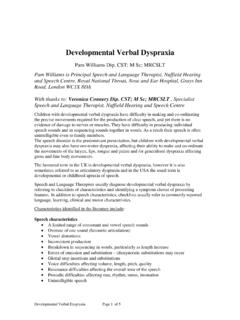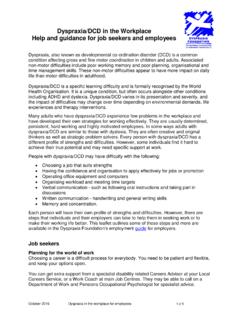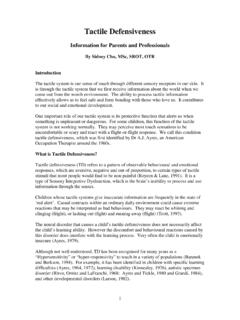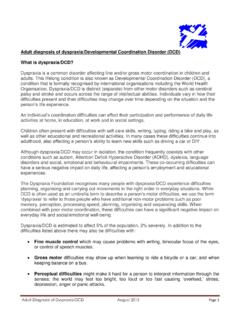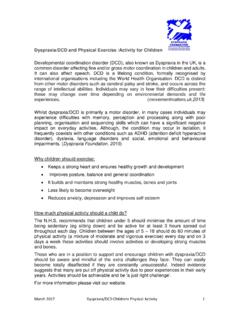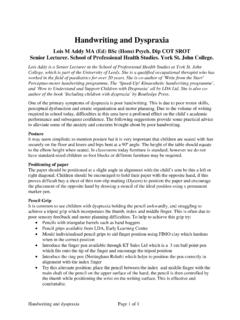Transcription of Dyspraxia from an Occupational Therapy perspective
1 Dyspraxia from an OT perspective 1 of 1 Dyspraxia from an Occupational Therapy perspective Natasha Patten BSc ( Occupational Therapy ) Natasha Patten is a Senior 1 Paediatric Occupational Therapist employed by the Royal Free Hospital, Pond Street, Hampstead, London, NW3 2QG Paediatric Occupational Therapy uses purposeful activity and play to work with the child to help him or her attain the highest possible quality of life. The Occupational therapist assesses the child and uses therapeutic techniques and activities to help maximise the child s abilities and independence.
2 (National Association of Paediatric Occupational Therapists) Some children frequently seen by an Occupational therapist include those who present with difficulties with motor, co-ordination and perceptual difficulties. There are a number of different terms commonly used to describe the group of children with co-ordination difficulties. They include Clumsy children, Developmental Dyspraxia , Co-ordination difficulties or perceptual motor difficulties. There is confusion in the use of these terms. Some clinicians use these terms interchangeably, others may use them to define slightly different problems.
3 Currently the preferred term worldwide is Developmental Co-ordination Delay or DCD (DSM-IV 1994, American Psychiatric Association Diagnostic and Statistical Manual). The diagnostic criteria for DCD are: A. Performance in daily activities that require motor co-ordination is substantially below that expected given the person s chronological age and measured intelligence. This may be manifested by marked delays in achieving motor milestones ( walking, crawling, sitting), dropping things, clumsiness , poor performance in sports, or poor handwriting. B.
4 The disturbance in Criterion A significantly interferes with academic achievement or activities of daily living. C. The disturbance is not due to a general medical condition ( cerebral palsy, hemiplegia, or muscular dystrophy) and does not meet the criteria for a Pervasive Developmental Disorder. D. If mental retardation ( learning difficulties) is present, the motor difficulties are in excess of those usually associated with it. Occupational therapists use DCD as an umbrella term which includes Dyspraxia . Some definitions of praxis / Dyspraxia include: Praxis is the ability by which we figure out how to use our hands and body in skilled tasks like playing with toys; using tools, including a pencil or fork; building a structure, whether a toy block tower or a house; straightening up a room, or engaging in many occupations.
5 (Ayres, Mailloux and Wendler, 1987) Dyspraxia from an OT perspective 2 of 2 Dyspraxia is defined as difficulty in planning and carrying out skilled non-habitual motor acts in the correct sequence. It is not a primary problem in motor co-ordination (motor execution). Rather the problem is hypothesized to be due to difficulty in formulating the plan of action. Praxis includes both knowing what to do and how to do it. (Ayres 1972a, 1979, 1985, 1989 in Fisher, Murray & Bundy, Sensory Integration: Theory and Practice , 1991, Davis Company, p.)
6 141) Ayres defined somatodyspraxia as a disorder of encoding a new, as opposed to a habitual, motor response strategy. That is, clients with somatodyspraxia have difficulty learning new tasks, but once learned and performed as a part of the client s daily life performance, the task can be performed with adequate skill. Although clients can acquire reasonable degrees of skill in specific activities with practice, the acquired skill remains highly specific to the particular tasks they have practiced and doesn t generalise to other similar activities. (Fisher, Murray & Bundy, Sensory Integration: Theory and Practice , 1991, Davis Company, p.
7 141) Praxis is the ability to interact successfully with the physical environment, to plan, organise and carry out a sequence of unfamiliar actions and to do what one needs and wants to do. (Kranowitz, , The Out of Sync Child , 1998, ) Praxis as defined from an Occupational therapist s perspective includes three components: 1. Ideation - the ability to grasp the idea to allow purposeful interaction with the environment. It involves knowing what to do with an object and being able to anticipate a plan of action. 2. Planning The ability to plan and structure a purposeful adaptive response involving the motor and sensory systems.
8 It involves knowing how to move, and being able to send the right messages from the brain to the relevant muscles and areas of the sensory system in order to carry out the movements. 3. Execution carrying out the movement, and putting the plan into action. A client must present with difficulties with ideation or planning to be regarded as dyspraxic from an Occupational Therapy point of view. Dyspraxia is not viewed as a primary problem in motor co-ordination. To further clarify we will compare children with co-ordination difficulties with those with dyspraxic problems.
9 Co-ordination difficulties Dyspraxia - Poor balance - Poor planning of movements - Difficulties with bilateral skills - Poor sequencing of movements (such as using 2 hands when cutting out - Poor organisation of self in the or catching a ball with 2 hands). environment Characteristics of a client with Dyspraxia : Play, developmental and educational characteristics 1.
10 Clumsy difficulty transitioning from one body position to another 2. poor tactile discrimination difficulty with feeling or localising a touch stimulus 3. inadequate body scheme difficulty relating their bodies to physical objects in environmental space / difficulty imitating actions of others / direction of movement may be disturbed, toys broken unintentionally 4. difficulty with sequencing and timing the actions involved in a motor task 5. slowness in learning activities of daily living (especially fastenings) Dyspraxia from an OT perspective 3 of 3 6.

